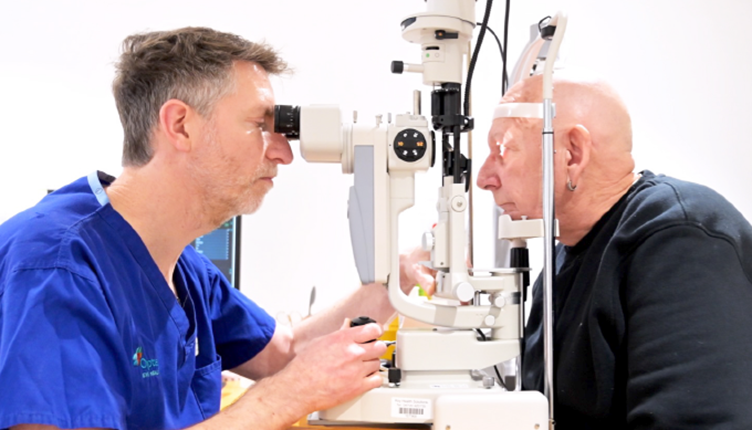Keratoconus: Here’s The Rub
Glaukos’ Clark Chang outlines the company’s recent campaign to boost keratoconus awareness
The non-inflammatory eye condition, keratoconus (KC), can lead to significant vision loss when left untreated – and as many as 1 in 5 patients with progressive KC will eventually have to undergo corneal transplant. Eye rubbing can be an underlying cause of the condition – but it can also manifest as a symptom, with blurred vision and frequent prescription changes also being causes for concern. The condition can be particularly aggressive in pediatric patients and, though not currently curable, progression can be slowed – or even halted – with the correct treatment.
One central issue with KC is the lack of public awareness of the disease, which affects approximately 1 in 2,000 individuals. And so, Glaukos – the developer of iLink (the only FDA-approved corneal cross-linking procedure for progressive KC) – has launched a multichannel awareness campaign called, rather aptly, “The Rub.” We spoke with Clark Chang, an optometrist at Wills Eye Hospital in Philadelphia and Director of Global Medical Affairs at Glaukos, to learn more about the campaign.
Why do you think public awareness of keratoconus is so low?
There is significant overlap between the presentation of early-stage keratoconus (KC) and a regular cornea, especially in the absence of advanced corneal imaging diagnostics. KC is an under-detected ocular condition – the impact of the disease and its progression are often underestimated, resulting in a low level of public awareness.
KC and its progression have been shown to create higher levels of mental stress and anxiety compared with other ocular diseases like age-related macular degeneration (AMD), glaucoma, and diabetic eye disease. So, it’s important to educate people about this progressive and life-altering disease. Keratoconus is the second most common indication for corneal transplantation, and it accounts for approximately 15–20 percent of all corneal transplants in children. Educating people to watch out for KC warning signs and to see their eye doctor regularly is one of the reasons that we launched “The Rub” campaign.
What role do regular eye exams play in the early detection and management of keratoconus?
Keratoconus is just one of many systemic and ocular health conditions that can be detected during eye exams, which is why it’s important for everyone – not just vision-corrected individuals – to get regular tests. In the earliest stages of KC, there are very few symptoms that would be noticed by a lay person. However, an optometrist or ophthalmologist can detect subtle early signs of the disease, including an unusual autorefraction, notable or increasing astigmatism (i.e., ≥ 2 D and increasing), notable or increasing keratometry (> 47 D and increasing), topographic irregularities, abnormal retinoscopic reflex, and difficulty refracting to a satisfactory 20/20. Earlier diagnosis and detection of progression could lead to earlier treatment with corneal cross-linking, better preserving the patient’s vision and corneal stability over the long term. Additionally, documentation of changes from prior eye exams is an important factor in determining whether KC is progressing.
Do genetic factors play a part in KC?
First-degree relatives of people with KC have a 15- to 67-fold greater risk of keratoconus than the general population, so genetics certainly play a role. However, that role isn’t yet fully understood. KC is polygenic, meaning that it is caused by the interaction among genes rather than by a single genetic mutation. Additionally, many patients with KC don’t have any family history of the disease, and so factors other than genetic mutation – such as epigenetics – are also involved.
From your experience, how does KC affect a patient’s daily life?
Given that the onset of KC can occur early in life and continue to progress, its debilitating effects on daily life and overall well-being can accumulate across a patient’s lifetime. KC often results in vision loss during the early years when individuals are maturing physically and cognitively. It can have a significant impact on relationships, educational advancement, job prospects, quality of life, and mental health outcomes.
People with KC report significantly impaired vision-related quality of life (QoL) that is often disproportionate to its effect on visual acuity, with declines in QoL that are similar to that of patients with severe macular degeneration. And more severe KC is associated with significant decline in reading, mobility, and emotional well-being; it has also been shown that the rate of depression, anxiety, and other psychiatric diagnoses in KC patients can be higher than in the overall population.
What are the early treatment options for KC?
Corneal cross-linking has been proven to slow or halt the progression of KC, preserving corneal stability and visual acuity, and reducing the likelihood of needing a future corneal transplant. Also, earlier intervention with corneal cross-linking has been demonstrated to reduce economic burdens on both KC patients and the US healthcare system.
In the US, Glaukos’ iLink is currently the only cross-linking treatment approved by the FDA. In addition, refractive rehabilitation should be carried out to optimize visual health outcomes once KC is stable after corneal cross-linking to further optimize patients’ QoL. There are many specialty contact lenses that can provide improved visual quality for KC patients, including recent contact lens technology advancements in correcting for residual higher order aberrations (HOA).
What are the key objectives of Glaukos’ “The Rub” campaign?
The campaign was designed to raise public awareness of the signs and symptoms of KC by driving people to take the KC Quiz. Knowing that eye rubbing is associated with keratoconus, we used that symptom as the entry point into the other warning signs that may be overlooked, including mildly blurred vision, difficulty seeing at night, frequent prescription changes, frequent headaches, vision that cannot be fully corrected with glasses or contact lenses, and a family history of KC. Like most diseases, KC at its early stages can present similarly to normal, healthy corneas. We hope to encourage people who have signs and symptoms of KC to see their eye doctor so that keratoconus can be diagnosed early.
As eye doctors, our main goal is to ensure our patients receive the best possible care for their visual and ocular health. We understand that keratoconus can be a scary diagnosis, but with early detection and proper treatment, we can help patients maintain their vision and quality of life.
The New Optometrist Newsletter
Permission Statement
By opting-in, you agree to receive email communications from The New Optometrist. You will stay up-to-date with optometry content, news, events and sponsors information.
You can view our privacy policy here
Most Popular
Sign up to The New Optometrist Updates
Permission Statement
By opting-in, you agree to receive email communications from The New Optometrist. You will stay up-to-date with optometry content, news, events and sponsors information.
You can view our privacy policy here
Sign up to The New Optometrist Updates
Permission Statement
By opting-in, you agree to receive email communications from The New Optometrist. You will stay up-to-date with optometry content, news, events and sponsors information.
You can view our privacy policy here







